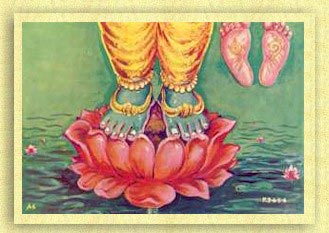According to the SRIVAISHNAVA teachers, one-pointed love (bhakti) and absolute surrender (prapatti) to the Lord are the two alternate means of liberation. They are adopted by people according to their own eligibility.
The word bhakti is derived from the root bhaj meaning, love and service. Bhakti is not mere emotionalism, according to RAMANUJA. It involves training one’s mind and intellect towards love for God. Non-stop constant contemplation is the very essence of bhakti. Bhakti is also known as upaasaana, vedana, jnaana, dhruvaa anusmriti,nididhyaasma and dhyaaana. RAMANUJA defines dhyaana as follows: tailadbaaraavat avicchinnasmriti-santaana-roopam
Dhyaana (steady meditation) is of the nature of an unbroken series of recollections about God) like flow of oil.
When such a meditation is possible, it is called bhakti and that will be efficacious in making one liberated.
It is also stated that bhakti has several aspects like hearing about God (shravana), singing His glories (keertana), remembering Him (smarana), serving His feet i.e., worshipping Him in holy places (paada-sevanam), worshipping Him according to the rules laid down in the sacred texts (archanam), prostrating before Him in all humility (vandanam), waiting upon Him like a servant (daasyam), considering oneself as His friend(sakhyam) and offering all that one has, includingone’s body to Him (aatma-nivedanam). SRI ROOPAGOSVAMI gives the following examples of persons who adopted these nine attitudes.PAREEKSHIT: shravana; SUKA: keertana; PRAHLADA: smarana; LAKSHMI: paada-sevana; PRITHU: archana; AKROORA: vandana; HANUMAAN: daasya; ARJUNA: sakhya; KING BALI: aatma-nivedana. Ancient teachers have also pointed out that bhakti as a discipline can be cultivated by adopting seven steps, called collectively, Jaadhana-saptaka. These are:
1. VIVEKA: discrimination. This is discriminationabout food. Talung sattvic food i.e., certain itemsof food which help increase the quality ofserenity (iattva) [e.g., sweets, fruits, ghee, milk,etc.] makes one’s mind pure. Purity of mindleads to steady contemplation.
2. VIMOKA: cessation of all desires for material enjoyment.
3. ABHYAASA: repeated thinking on the Lord. This shows that for a majority of aspirants (idaka-s), concentration on the Lord will not be that easy.
4. KRIYAA: performing five great sacrifices, (panchamahaa-yajna-s) according to one’s capacity. They are:
(a) study/teaching of sacred texts (called brahma-yajna, where the word brahma stands for VEDA);
(b) pleasing the departed souls (tarpana) by offering food, water, etc. (This is called pitri-yajna);
(c) performing fire-rituals to please the gods (homa). (This is called daiva-yajna);
(d) Offering food (bali) to Other living beings like birds and animals (bhoota-yajnn); and
(e) hospitality to guests and unexpected visitors (nara-yajnn)
5. KALYAANA: cultivating auspicious qualities like truthfulness, non-injury to animals and straightforwardness.
6. ANAVASAADA: not losing one’s heart even in the worst calamity and continuing contemplation on the Lord with cheerfulness.
7. ANUDDHARSHA: non-exultation or absence of undue joy even when there appear indications that God is becoming favourable.
Although these seven steps are sure to cultivate bhakti, they are not easy for an ordinary man or woman to follow. This therefore, throws open the gate for the other alternative, viz., whole-hearted absolute surrender to God called saranaagati or prapatti
Source
Sri Nrisimha Priya









